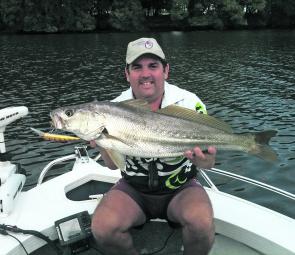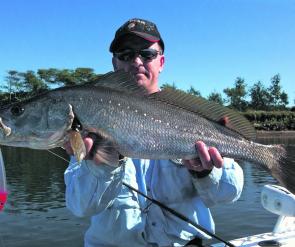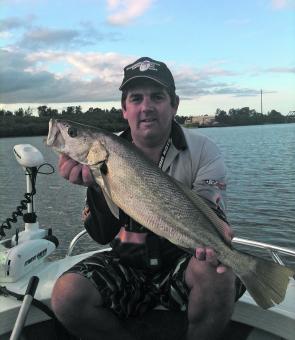With the morning fog so dense, I did not want to travel too far up river until it lifted, so to fill in a bit of time I decided to troll a gold Reidy’s Judge along a drop-off near a prominent rock bar.
With the depth varying from 5m-7m, this lure would get me down to where I needed to be. The troll run was about 500m long and would put me near the main road bridge that I intended to fish.
I was nearing the end of the run and my thoughts were wandering to which soft plastic would be used first off, so when I felt the slightest bump on my rod tip I snapped back to attention. Seconds later, this light touch was followed by a heavy lunge, which doubled the rod over.
Things had gone from slow to wow in a second and I was battling to get this fish away from the rocks. I coaxed it from the rock bar below out into the open and we landed a nice 80cm mulloway.
To say I was excited is an understatement and my mind was now racing with the possibilities of chasing these fish up river on my barra gear. The penny had dropped. Oh well, sometimes it takes a while!
Guiding on the Mid North Coast, we constantly have anglers wanting to learn to catch the river’s most majestic fish, Argyrosomus japonicus, the mulloway or jewfish.
While a majority of these fish are caught on soft plastics these days, more fishos are using their barra outfits to chase these fish and we have found casting and trolling to be extremely effective and rewarding.
If you are familiar with your local river’s jewie spots, you are already on your way because your barra lures will catch fish in these possies at some stage. Let’s look at some scenarios.
When they think of jewfish, many anglers do not think of trolling and they can miss out on some great opportunities.
A lot of fishos head for the deepest water they can find but this is not necessarily the only spot worth targeting.
We fish in 3m-9m water when trolling and a lot of times we cast into 3m-5m depths.
When trolling, look for rock walls and rock bars and use your sounder to look for bottom structure and baitfish. Remember, where you find the bait the predators will not be far away.
When you have decided on a location you are going to fish, it’s the time to select lures and this can be tricky. Many fishos now lure boxes so big it’s a mind-boggling decision on what to tie on.
If there are two anglers on board we usually go for a diver that will periodically touch bottom and the other we run at mid-water.
Again, look at your sounder to find where the bait is situated. If baitfish are on the bottom, use the appropriate diving lure and if it’s mid-water you can use a shallower runner.
The lures we use range from 10cm-20cm and there are some great lures out there for this job. We use Reidy’s, Halco Lasers and Hammas, some great suspending lures from Maria and plenty of others from the barra box.
When trolling I have no issue using the four-stroke motor, especially if the water has a bit of tidal movement still happening. I have not noticed a catch difference when using my electric.
I troll my lures 20m-50m back, depending on structure fished.
And as for speed, get a feel for it by the vibration at your rod tip. Remember if it’s not bouncing it probably is fouled or you are going too slowly.
When working a likely spot it pays to do a couple of runs over the area and trial different coloured lures. On one of my rods I like a lure with gold or orange or a combination of both. They are proven colours for me so that’s a confidence thing.
On the other rod I mix it up. This rod is usually in a holder and the lure I put on the rod I’m not holding is a mid-water runner.
You should be able to tow this mid-runner without snagging, meanwhile holding and working the rod with your deeper lure. This will help you manoeuvre the lure through trickier bottom because you will be able to drop back your rod when the lure fouls, allowing it to rise over the obstruction.
This will make your troll run more productive.
There are definitely times when we have a better chance of hooking up. Early morning or late afternoon tide changes are prime time in my river.
Remember, in a tidal system this can give you a great amount of time fishing because you can often move ahead of the tide.
Having the lures in the water for a longer period is going to get you more chance at cracking a decent jew.
Tide changes in the middle of the day will still catch fish. Many of our trips have resulted in bites around a midday tide change.
Some anglers think trolling can be a bit boring but on those days when you’re prospecting new areas, it can be a real eye opener when you pull a fish when other methods have failed.
It is also a good way of learning your river system. Constantly monitoring your sounder and finding snags and structure on the bottom will be of benefit when going over these areas later on with your plastics.
Most jewfish will lie up against structure, moving out only when food presents itself nearby. So casting hardbodies into the structure and working them back can be an exceptional way to hook fish.
A lot of times the strike will come as you work the lure down a rock bar, near a bridge pylon or tight to an eddy along a rock wall. All of these are prime jewfish haunts.
We’re not talking about the ocean breakwall jewies caught on 10’ heavy-duty rods and 50lb-80lb line; we are using our barra gear and baitcaster tackle.
What we can do from the boat is a lot more manoeuvrable than fishing from the shore.
The trick when fishing a rock bar which leads into deeper water is to cast in very tight to the bank. Most of the hits come as soon a lure dives down over the edge.
It pays to be aware that a hit can come after a couple of cranks, so be on your game when casting to structure.
Bridge pylons are great spots. They usually have reasonably depth and often hold baitfish. Again, keep one eye on the sounder and choose lures to suit your depth and where bait is holding.
I like to face the boat into the tide and cast along the pylons, trying each from different angles.
I have a few rods set with different hardbodies for quick lure changes, remembering that every minute of tide change it’s important to have a lure in the water, not going to and from the tackle box.
Once the run starts to freshen, it’s time to move on.
Breakwalls are great if you’re lucky enough to find a stretch where there are no shore-based anglers. Some truly big fish get landed along these walls.
If the situation arises and conditions are good, casting parallel to the wall is a winner. This way you work your lure along the structure for the entire length.
Look for bends in the wall where water movement is altered, and for eddies formed by boulders and depth changes. Cast past the eddy and bring the lure back through once it has time to get to the required depth.
This style of fishing is thoroughly enjoyable and you will tangle with some good-sized mulloway and some big flathead as by-catch.
When the moment arises and you finally have your jewie at the side of the boat, try to remain calm. We use the large Enviro-style landing nets so as not to damage any fish we release.
A wet brag mat records the length, and you can leave the lure there for the photo. Take a couple of pics supporting the belly of fish at different angles and you can send it back on its way, no harm done.
And if you keep one for a feed, kill it humanely, bleed it and make sure you have ice on board. Make the effort to look after your catch because one decent jewfish will give you a few good meals.
So grab a handful of lures to suit a few different depths and give it a try.
Who knows, a quick troll along one of those rocky banks may produce the fish of a lifetime.
Most important, you can cover some ground, learn your river’s secrets and you will be on your way to landing some great fish. Give it a try; don’t just put those barra lures in the cupboard!
Facts
GEAR
Tackle varies on location. Baitcast or spin gear will do the job and if you have barra casting gear, so much the better.
Rods: 4kg-6kg and 6kg-8kg, spin or baitcast. Fast action in the tip and plenty of grunt in the butt. Remember, this gear will be there when you do the big trip north!
Reels: I have Shimano and Daiwa reels with smooth, progressive drags on board.
Line, leader: Sunline 8kg PE Jigger braid, 16lb-30lb Sunline FC Rock, depending on structure being fished.
Have the best quality you can afford. Your local tackle store should be able to advise you.
Facts
MULLOWAY ON HARDBODIES TIPS
• Fish tide changes, preferably early morning or late afternoon.
• Days up to the full moon are best but if the tides are right, fish!
• Target holes on river bends, bridge pylons, rock bars, and breakwalls.
• Lures: Reidy’s Judge, Halco Hamma, and Maria floating MJ-1DD are favourites.

Some of the author’s favourite lures for chasing mulloway.

Great by-catch when trolling or casting hardbodies. Remember, flathead of this size are females that deserve to be released to make more flatties.

This mulloway took a liking to the author’s favourite coloured Reidy’s Judge on a foggy morning.

A close up view of the dental work on a Reidy’s-munching mulloway.

Mangrove drop-offs and rock bars provide great structure to cast or troll a hardbody.

Although the bank doesn’t look promising, there is a deep drop-off only a metre from the shore for a 500m stretch. When the baitfish are about mulloway like this one, caught by Bernie Davies on a Halco Hamma, are quite common.

There’s nothing like picking out a new lure and coming up trumps. This red head Hamma took the second fish of the morning.

Late afternoon is another prime time to be casting or trolling. This fish inhaled a Koolabung Razorback barra lure just as the tide stopped.

Bridge pylons are jewfish magnets and great places to cast your hardbodies.





